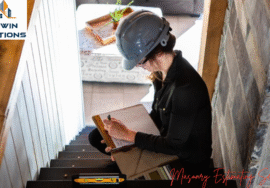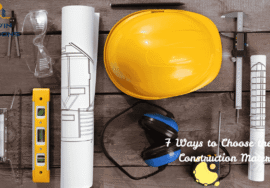
Differences Between Residential and Commercial Construction
In construction, not all projects are the same. One of the biggest distinctions lies between residential and commercial work. While both involve building structures, they follow very different rules. From design to estimating, every detail shifts depending on the type of project.
This article will explore the key differences between residential and commercial construction. We’ll also explain what is the difference between construction estimating, concrete estimating, plumbing estimating strategies, and more things across these two sectors.
The Basics: What Sets Them Apart?
- Residential construction includes houses, flats, and small multi-family dwellings. These are built for people to live in.
- Commercial construction includes offices, shops, schools, hospitals, and industrial spaces. These are built for business or public use.
The goals, budgets, materials, and timelines all differ. So does the scale of each project.
-
Design and Planning

In residential work, designs are simpler. Homes follow basic floorplans. Customisation is minimal unless it’s a luxury project. The main focus is comfort and liveability.
Commercial projects are far more complex. Designs must follow business requirements, safety codes, and heavy usage needs. Think lifts, multiple floors, wide corridors, and emergency exits.
This difference affects every part of the planning stage. It also impacts on construction estimating, as costs rise with complexity.
-
Project Scale and Timeline
Residential projects are smaller in size. A single-family home may take a few months.
Commercial projects are much larger. A hospital or shopping mall can take years to build. These timelines demand strict coordination across trades.
This affects overall electrical estimating, and plumbing estimating of these two projects. Each trade must work in sync to avoid delays. Residential jobs may have more flexibility.
-
Permits and Regulations
Both residential and commercial projects require permits. But commercial work follows more strict codes.
Fire safety, access control, load-bearing capacities, and ventilation are all heavily regulated.
This creates more paperwork. It also affects how builders plan for materials, labor, and inspections. Your construction estimation must reflect these regulatory demands.
-
Materials and Structural Requirements
Homes use lighter materials. Timber framing is common. Insulation and drywall are standard.
Commercial buildings often need steel frames, reinforced concrete, and fireproof panels. They may use curtain walls or precast panels.
That’s why steel estimating, concrete estimating, and lumber estimating strategies change drastically between the two.
Steel and concrete are rarely used in small home builds, but they’re essential in multi-storey commercial work.
-
Labor and Equipment
Residential crews are small. A few tradespeople can handle most tasks.
Commercial sites require many workers. Electricians, HVAC teams, welders, and heavy machine operators may all be working at once.
The equipment also differs. Residential sites may only need basic tools. Commercial sites need cranes, lifts, concrete pumps, and more.
Labor costs and equipment rentals make up a big part of commercial construction estimation.
-
HVAC and Electrical Systems
Heating and cooling in homes are simple. A single unit can serve the whole house.

Commercial systems are far more advanced. Multi-zone air conditioning, industrial exhaust, and data centre cooling are common.
This makes more detailed HVAC estimating in commercial work and much more costly.
Electrical systems also vary. Homes need basic wiring, switches, and sockets.
Commercial buildings need large-scale panels, backup systems, and smart networks. This affects electrical estimating plans significantly.
-
Plumbing Systems
Plumbing in residential homes is straightforward. One kitchen, a few bathrooms, and a single water heater.
In commercial spaces, plumbing is on a larger scale. Think of shopping centres, schools, or hospitals. Each may have dozens of toilets, sinks, and water systems.
Commercial plumbing must also handle high usage, backflow prevention, and special drainage needs.
So plumbing estimation for commercial jobs requires careful detail and more materials.
-
Finishing Work
In residential construction, finishes matter a lot. Paint, flooring, cabinets, and lighting must suit the homeowner’s taste.
Painting estimating plan in residential work includes color consultation, trim work, and fine detail.
Commercial finishes are more practical. Durability, safety, and branding matter more than style. Think of industrial paint, fire-rated panels, or slip-proof flooring.
Drywall estimating and painting estimating strategies also shift in both places. Commercial spaces need longer walls, sometimes with metal studs, and different paint types.
-
Budget and Finance
Residential projects usually have limited budgets. Homeowners often take loans or save for years to build or renovate.
Commercial projects have bigger budgets. They’re backed by investors, developers, or public funds. With more money comes more complexity. Cost tracking, procurement, and project management tools are essential.
This puts more pressure on precise construction estimating plans. One mistake in a commercial estimate can cost thousands.
-
Communication and Management
Residential jobs involve direct client communication. Often, it’s a homeowner or small developer.
Commercial projects involve multiple stakeholders. Architects, consultants, property owners, legal teams, and investors all have input.
This changes how builders communicate. More reporting. More coordination. Delays can be costly and involve legal steps.
That’s why commercial builders often have dedicated estimating teams for tasks like steel estimating, concrete estimating, and HVAC estimating plans.
-
Risk and Liability
Commercial construction carries more risk. Bigger budgets mean more at stake. Workplace safety, legal compliance, and insurance requirements are stricter.
Residential projects have risks too. But the scale of loss is smaller. A missed step in a home build may lead to a few days’ delay. A similar error in a commercial job could shut the site down. This is why construction estimating accuracy is so important.
-
Customisation and Repeat Work
Residential builds vary. Every homeowner wants something unique. That means more one-off planning. Commercial builds are often repeated. Developers may copy the same design across multiple locations.
This allows commercial contractors to refine their estimating models. It also helps them improve speed and reduce waste.
-
Technology and Innovation
Commercial firms often invest more in tech. Drones, BIM, project tracking apps, and digital estimating software are standard. In residential work, tech adoption is slower. Many small builders still rely on manual estimating.
This difference affects how construction estimating is done. Commercial estimators may use tools to handle plumbing, electrical, and HVAC estimating in one integrated platform.
Final Thoughts
The gap between residential and commercial construction is wide. From design to delivery, each sector demands its own approach.
If you’re working in one, don’t assume the rules carry over. Even simple tasks like drywall estimating or steel estimating can change based on scale and use.
Builders, estimators, and clients must understand these differences. When you do, you can plan better, build faster, and stay on budget. So whether it’s a family home or a high-rise tower, success starts with knowing the difference—and estimating everything accordingly.









